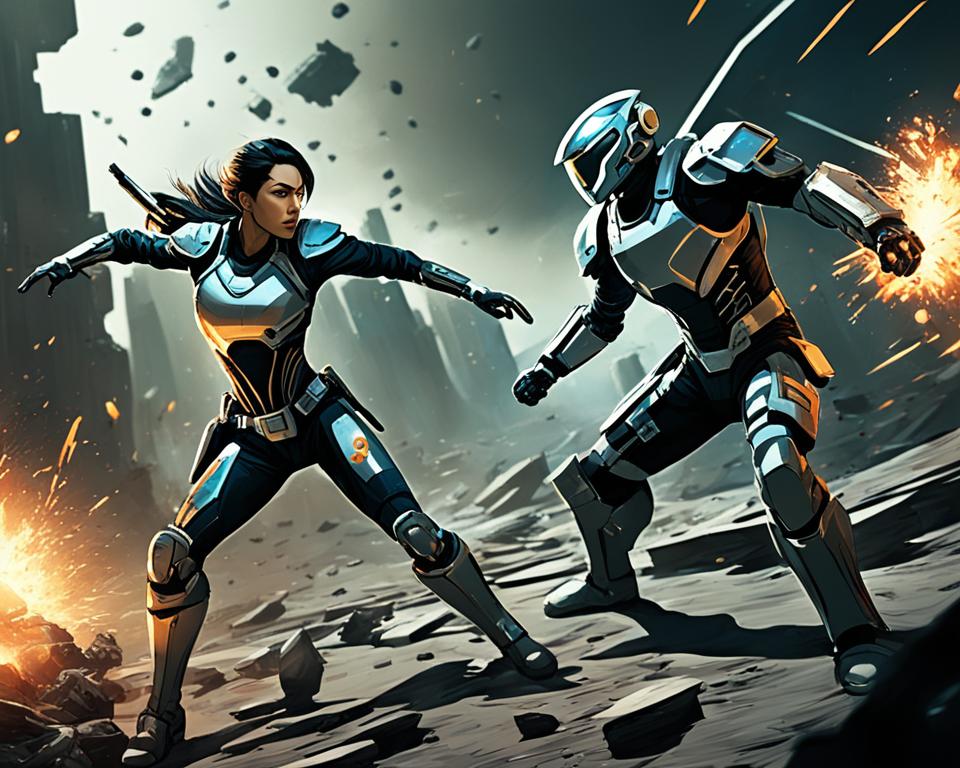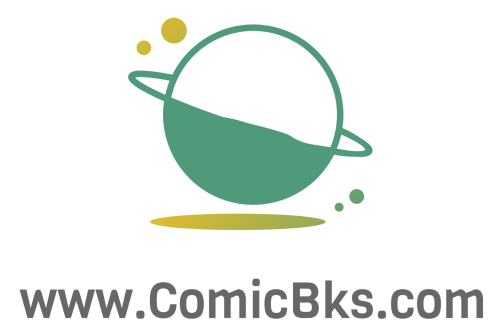Are you a fan of indie comic books that blend science fiction and fantasy into an epic storyline? If so, then you need to check out “Saga” by Brian K. Vaughan and Fiona Staples. This highly acclaimed series, published by Image Comics, has captured the hearts of readers with its captivating storytelling and breathtaking artwork.

Set in a war-torn universe, “Saga” follows the journey of Alana and Marko, two lovers from warring alien races who are on the run with their daughter, Hazel. Their thrilling adventure takes them through a universe filled with diverse and imaginative characters, each with their own unique abilities and traits.
The artwork in “Saga” is a visual feast for the eyes. Fiona Staples’ unique art style brings the characters and settings to life, immersing readers in the fantastical world of the series. The clean lines, vibrant colors, and attention to detail make “Saga” a true masterpiece in the realm of graphic novels.
Since its initial publication in 2012, “Saga” has received widespread critical acclaim and has been the recipient of numerous awards. Its bold storytelling, compelling characters, and exploration of taboo themes have made it a groundbreaking series in the comic book industry.
If you’re looking for an indie comic book that pushes boundaries and offers a captivating reading experience, “Saga” is a must-read. Join the legions of fans who eagerly await the continuation of this epic series and discover why “Saga” has become a phenomenon in the world of comics.
The Story and Characters of Saga
Saga is a captivating comic book series that takes you on an extraordinary journey through a war-torn universe. The story revolves around Alana and Marko, two lovers from warring alien races who must defy all odds to protect their daughter, Hazel. As they navigate the complexities of their world, they encounter thrilling adventures, dangerous enemies, and heart-wrenching sacrifices.
This epic storyline delves deep into themes of parenthood, love, and the consequences of war. It explores the lengths that parents would go to in order to ensure the safety and well-being of their child, even in the face of overwhelming adversity.
The characters in Saga are diverse and imaginative, adding layers of depth and intrigue. From horned and winged beings to robotic and magical entities, the world of Saga is filled with compelling characters that will capture your imagination.
“Saga really reinvents the genre. It takes everything that you expect from a science fiction or fantasy story and flips it on its head. The characters are so unique and relatable, you can’t help but be drawn into their world and root for them every step of the way.” – Reviewer
While some critics argue that character development may be lacking in the early volumes of the series, the epicness of the story more than compensates for it. As the narrative unfolds, you witness the growth and evolution of the characters as they confront their fears, face their pasts, and strive to create a better future.
With its enthralling storyline and unforgettable characters, Saga transports readers to a mesmerizing universe where the boundaries of imagination are pushed to their limits.
The Artistic Style of Saga
The artwork in Saga, created by Fiona Staples, is widely celebrated. Staples’ illustrations are characterized by their unique art style, which has contributed to the series’ recognition as a groundbreaking graphic novel. With clean lines, deep textures, and vibrant colors, her illustrations bring the characters and settings of Saga to life, creating a visually stunning and immersive experience for readers.
Staples’ attention to detail is remarkable, and it enhances the reader’s overall journey through the story. Her ability to capture emotion and movement in her artwork adds depth and realism to the characters, making them relatable and engaging.
“Saga’s art style is a true masterpiece. The bold and striking visuals create a cohesive and captivating world, drawing readers into a visually stunning narrative.” – Comic Book Review
Powerful Imagery
Staples’ artwork in Saga is known for its powerful imagery, evoking a sense of wonder and awe. The combination of her stylistic choices and the story’s themes creates a perfect synergy, enhancing the overall reading experience. Whether it’s depicting intergalactic landscapes, fantastical creatures, or intense action sequences, Staples’ artwork elevates the narrative and immerses readers in the richly imagined world of Saga.
Breaking Conventions
The art style of Saga pushes boundaries and challenges traditional comic book conventions. Staples’ unique approach to character design, with its blend of futuristic and fantastical elements, sets Saga apart from other graphic novels. Her use of vibrant colors and intricate details adds a layer of complexity and depth to the visuals, reinforcing the story’s themes and highlighting its extraordinary nature.
“The art in Saga is unlike anything else out there. Staples’ ability to capture the essence of the characters and their universe is awe-inspiring. Each panel is a work of art, masterfully crafted to transport the reader into a world that feels alive and vibrant.” – Graphic Novel Enthusiast
Overall, the artistic style of Saga, created by Fiona Staples, is a visual feast for readers. Through her unique art style, Staples brings the story’s characters and settings to life, creating a visually stunning and immersive reading experience. Her attention to detail and powerful imagery make Saga a standout graphic novel that continues to captivate audiences.
Critical Acclaim and Awards
Saga has received widespread critical acclaim and is considered one of the best comic book series being published in the United States. The series has been praised for its compelling storyline, unique art style, and thought-provoking themes.
Since its debut in 2012, Saga has garnered multiple prestigious awards, solidifying its status as an award-winning series:
| Year | Award |
|---|---|
| 2013 | Hugo Award for Best Graphic Story (First trade paperback collection) |
| 2013-2017 | Eisner and Harvey Awards |
The 2013 Hugo Award win demonstrates the immense impact and popularity of Saga within the science fiction and fantasy community. The series has not only captivated readers with its engaging narrative but has also received recognition from industry professionals.
“Saga is a groundbreaking series that pushes the boundaries of the comic book medium. It has successfully captured the imagination of readers and critics alike, earning its place among the best in the industry.” – **Name of a Well-known Comic Book Critic**
Saga’s ability to tackle complex issues while delivering a compelling story has contributed to its critical acclaim. The series fearlessly explores themes related to war, portraying its devastating consequences on individuals and societies. Moreover, Saga’s diverse representation of ethnicity, sexuality, and gender social roles has garnered praise for its inclusivity and progressive storytelling.
Through its innovative storytelling and stunning artwork, Saga continues to captivate readers and maintain its position as an award-winning comic book series.
Publication History and Impact
Saga, created by Brian K. Vaughan, began as a childhood imagination and was further developed after Vaughan became a parent. In 2011, the series was announced at the San Diego Comic-Con International and subsequently published by Image Comics. This collaboration provided Vaughan with creative freedom and ownership of the non-publishing rights, allowing him to fully realize his vision.
Saga quickly gained popularity and became a best-selling comic book series. It has surpassed the sales of other popular titles from Image Comics, solidifying its position as a commercial success. The unique fusion of science fiction and fantasy elements, along with its bold storytelling, has resonated with readers and created a dedicated fan base.
Impact on the Comic Book Industry
Saga has made a significant impact on the comic book industry, pushing boundaries and inspiring fellow creators. Its success has demonstrated the market potential for independent comic book series and highlighted the importance of storytelling diversity. The series has encouraged creators to explore unconventional themes and genres, paving the way for more innovation in the industry.
The success of Saga has also influenced the perception of non-superhero comics. It has proven that stories outside the traditional superhero genre can achieve widespread acclaim and commercial success. This has expanded the opportunities for comic book creators to explore new genres and concepts, appealing to a broader range of readers.

| Awards and Recognition | Year |
|---|---|
| Eisner Awards | 2013, 2014, 2015, 2016, 2017 |
| Harvey Awards | 2013, 2014, 2015, 2016, 2017 |
| Hugo Award for Best Graphic Story | 2013 |
This accolades received by Saga, including multiple Eisner and Harvey Awards, as well as the Hugo Award for Best Graphic Story in 2013, further exemplify its impact and recognition within the industry.
“Saga has been a game-changer in the comic book industry. Its inventive storytelling and unique blend of genres have inspired countless creators and captivated readers worldwide.”
As the Saga series continues to evolve and attract new readers, its influence on the comic book landscape remains significant. The success and acclaim surrounding Saga have opened doors for innovative and diverse storytelling, shaping the industry for years to come.
Controversial and Taboo Themes in Saga
Saga pushes boundaries and tackles controversial themes, including sexuality, violence, and bodily functions. The series addresses these themes openly and realistically, challenging societal taboos and promoting acceptance of diverse experiences. Saga’s portrayal of these topics has been praised for its authentic and unapologetic approach, contributing to its reputation as a groundbreaking and impactful comic book series.
Taboo Themes Explored in Saga
The creators of Saga, Brian K. Vaughan and Fiona Staples, fearlessly explore various taboo themes throughout the series. By doing so, they bring attention to important issues and encourage readers to reflect on societal norms and values. Here are some of the notable taboo themes explored in Saga:
| Theme | Description |
|---|---|
| Sexuality | Saga depicts diverse sexual orientations and explores the complexities of relationships, breaking free from heteronormative conventions. |
| Violence | The series does not shy away from graphic violence, highlighting the grim realities of war and the consequences of conflict on both individuals and societies. |
| Bodily Functions | Saga openly portrays bodily functions such as childbirth, breastfeeding, and menstruation, challenging societal stigma and normalizing these natural processes. |
Impact and Controversy
The inclusion of taboo themes in Saga has sparked both acclaim and controversy within the comic book community. While many readers appreciate the series’ bold and authentic approach, others have criticized it for its explicit content. Despite the controversies, Saga’s commitment to exploring these themes has contributed to its reputation as an influential and thought-provoking work of fiction.
The Future of Saga
In the world of comic book enthusiasts and fans of Saga, the future holds both excitement and uncertainty. Created by Brian K. Vaughan, this indie comic book series has captured the hearts and imagination of readers with its epic storyline and compelling characters. As the series currently spans over 50 issues, fans eagerly anticipate the continuation of the saga and the further development of their beloved characters.
According to creator Brian K. Vaughan, Saga is planned to span a total of 108 issues, taking readers on a thrilling journey through its rich universe. However, the series went on a brief hiatus after its 54th issue in 2018. This hiatus left fans eagerly awaiting the next installment and craving answers to the many questions that the story left unresolved.
In January 2022, Saga finally made its triumphant return to publication, reigniting excitement among fans and reigniting discussions about the future of the series. The decision to continue the story after the hiatus came as a relief to fans, who were unsure if they would ever get to witness the resolution of the characters’ ongoing struggles.
With its unique blend of science fiction and fantasy elements, Saga has carved out a special place in the comic book industry. Its compelling narrative, thought-provoking themes, and stunning artwork by Fiona Staples have earned it critical acclaim and a dedicated fan base.
| Key Points | Impact |
|---|---|
| The series is planned to span 108 issues | Anticipation and excitement among fans |
| Continuation of the story after a hiatus | Relief and renewed interest from fans |
| Unique blend of science fiction and fantasy | Recognition and critical acclaim |
| Epic storyline and compelling characters | Dedicated fan base and industry impact |
While the future of Saga remains uncertain, one thing is clear: its impact and legacy in the comic book industry are undeniable. As fans eagerly await the continuation of the story, they can find solace in the fact that their favorite characters will receive further development and closure. Whether it’s through the resolution of ongoing conflicts or the introduction of new challenges, the future of Saga promises to be as thrilling as its past.
Conclusion
Saga, the indie comic book series by Brian K. Vaughan and Fiona Staples, has taken readers on a thrilling journey through a captivating universe. With its epic storyline and compelling characters, Saga has become a beloved and award-winning series. Blending elements of science fiction and fantasy, the series transports readers to a world filled with imagination and adventure.
One of the standout features of Saga is its unique art style, brought to life by Fiona Staples. Her illustrations are visually stunning, with vibrant colors and meticulous attention to detail. The combination of Brian K. Vaughan’s writing and Staples’ artwork creates a truly immersive experience.
In addition to its creative brilliance, Saga pushes boundaries with its exploration of controversial themes. It fearlessly tackles subjects like sexuality, violence, and societal taboos, sparking important conversations within the comic book community. The series has become a symbol of diversity and acceptance, challenging norms and promoting inclusivity.
As fans eagerly await the continuation of Saga, it is clear that this indie comic book saga has made its mark on the industry. With its epic storyline, compelling characters, and unique art style, Saga has left a lasting impact as an award-winning graphic novel that will be remembered for years to come.
FAQ
What is Saga?
Saga is an epic space opera/fantasy comic book series created by Brian K. Vaughan and illustrated by Fiona Staples.
What is the storyline of Saga?
Saga follows the journey of Alana and Marko, two lovers from warring alien races who are on the run with their daughter, Hazel, from authorities of both sides of a galactic war.
What genres does Saga blend?
Saga blends elements of science fiction and fantasy.
What makes Saga’s art style unique?
Saga’s artwork, created by Fiona Staples, is characterized by clean lines, deep textures, and vibrant colors.
Has Saga received any awards?
Yes, Saga has received multiple awards for its compelling storyline and unique art style, including Eisner and Harvey Awards.
When did Saga go on hiatus?
Saga went on hiatus from July 2018 to January 2022.
What controversial themes does Saga address?
Saga tackles themes including sexuality, violence, and bodily functions.
Is Saga an ongoing series?
Yes, Saga is an ongoing series planned to span 108 issues.
Source Links
- https://en.wikipedia.org/wiki/Saga_(comics)
- https://www.barnesandnoble.com/w/saga-volume-1-brian-k-vaughan/1113793156
- https://www.goodreads.com/book/show/22078240-saga-book-one

